Agaricus devoniensis P. D. Orton - Sandy Mushroom
Phylum: Basidiomycota - Class: Agaricomycetes - Order: Agaricales - Family: Agaricaceae
Distribution - Taxonomic History - Etymology - Identification - Culinary Notes - Reference Sources
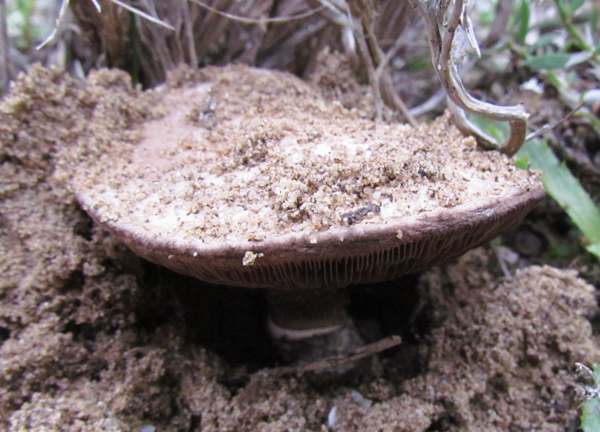
Agaricus devoniensis is a mushroom of sandy places - indeed, in Britain it is rarely seen anywhere but on coastal sand dunes. The lower slopes of dunes close to the dune slacks are likely places for this rather elusive species.
Distribution
Infrequent in Britain and Ireland, Agaricus devoniensis occurs also in many parts of mainland Europe. The specimens shown on this page were photographed on the southeast cost of Portugal.
Agaricus devoniensis vies with the Pavement Mushroom, Agaricus bitorquis, for the title of most boring member of the once mighty Agaricus genus. (In the early days of mycology, virtually all gilled fungi were placed in this genus; most have subsequently been relocated to the other genera such as Cortinarius, Entoloma, Hygrocybe, Pluteus, Tricholoma etc.) What is surprising about this otherwise undistinguished mushroom is the fact that something so substantial can survive in what appears to be an almost entirely barren habitat. Perhaps the fact that death comes to so many creatures that venture into bare sand dunes on baking hot days means that there is always something in the way of organic matter for these and other dune fungi to feed upon.
Taxonomic history
First described in 1960 by British mycologist Peter Darbishire Orton (1916 - 2005), who gave it the scientific name Agaricus devoniensis, this species still retains its original name.
Synonyms of Agaricus devoniensis include Psaliota arenicola (Wakefield & Pearson) Pilat., and Agaricus arenophilus Huijsman.
Etymology
The specific epithet devoniensis was given to this mushroom in 1960 by British mycologist Peter Darbishire Orton and is a reference to the English county of Devon in which it was first recorded.
Identification guide
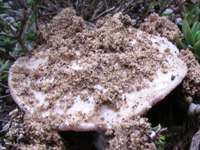 |
CapInitially convex before flattening and sometimes becoming slightly concave, the silkily smooth white caps range from 4 to 7cm in diameter at maturity. |
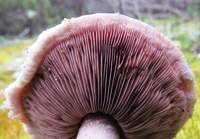 |
GillsPale pink at first, the free densely crowded gills turn dark brown and eventually almost black as the fruitbody matures. |
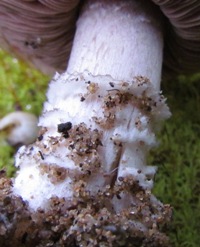 |
Stem3 to 4cm tall and 1 to 2cm in diameter, the white stems are smooth above the narrow, ring-like remnants of the partial veil. The stems are more or less cylindrical but sometimes slightly swollen at the base, which turns slightly reddish when cut or bruised. The fragile ring is usually ephemeral, and by the time the fruitbody is fully developed there is rarely much evidence of a ring remaining. |
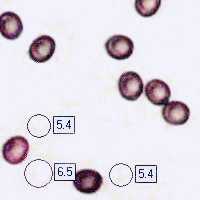 |
SporesOvoid or subglobose, 6-7 x 4.5-5.5µm. Spore printDeep chocolate brown. |
Odour/taste |
Taste mild; odour not distinctive. |
Habitat & Ecological role |
Saprobic, on bare or lightly vegetated areas of coastal sand dunes. |
Season |
July to October in Britain and Ireland. |
Similar species |
Agaricus bitorquis, the Pavement Mushroom, is very similar but with a thin double ring; it favours dry, compacted places beside paths. Agaricus littoralis (Wakefield & Pearson) Pilat. also occurs in sand dunes; its cap is ochraceous brown and the spores are more elongated, typically 7 x 4.5µm, whereas the spores of Agaricus devoniensis are on average about 6.5 x 5µm. |
Culinary Notes
Despite its rarity, some people ask only one question about this little mushroom: "Is it edible?" The answer is that it is as edible as any nice meal topped with a liberal sprinkling of sand... you simply have to grit your teeth and get on with it.
Reference Sources
Fascinated by Fungi, 2nd Edition, Pat O'Reilly 2016, reprinted by Coch-y-bonddu Books in 2022.
The genus Agaricus in Britain, 3rd Edition, self-published, Geoffrey Kibby 2011
BMS List of English Names for Fungi
Dictionary of the Fungi; Paul M. Kirk, Paul F. Cannon, David W. Minter and J. A. Stalpers; CABI, 2008
Taxonomic history and synonym information on these pages is drawn from many sources but in particular from the British Mycological Society's GB Checklist of Fungi.
Fascinated by Fungi. Back by popular demand, Pat O'Reilly's best-selling 450-page hardback book is available now. The latest second edition was republished with a sparkling new cover design in September 2022 by Coch-y-Bonddu Books. Full details and copies are available from the publisher's online bookshop...

